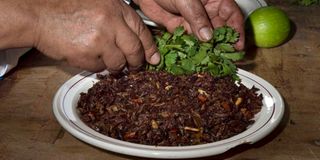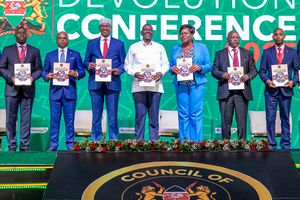Premium
Culture and the challenge of the grasshopper ‘dudupreneur’

A serving of 'chapulines' (grasshoppers) flamed in mezcal and parsley.
What you need to know:
- Eating grasshoppers, termites, caterpillars, snails, frogs or dogs may be common ways in which some given societies live their lives.
- Members of these societies, however, would not necessarily take kindly to having grasshoppers sold and crunched aboard international flights.
In Kiswahili, we call entrepreneurs wajasiriamali. The label, built on the root “jasiri”, suggests a kind of daring courage, ready and willing to stake one’s resources on the prospects of making a profit. This is what came to my mind as I watched the widely circulated video of a guy hawking grasshoppers (senene) on an international flight from Entebbe to Dubai.
It certainly takes a certain amount of brazen daring to stride up and down the aisles and rows of an international airliner, measuring spooning fried senene into small plastic packs and selling them to passengers for a few thousand shillings each. Apparently, there was a lot of enthusiasm among the passengers, many of whom relished the dudus as a delicacy. But dudus they were and our entrepreneur deserves the hefty title of “duduprenuer”.
Anyway, beyond the mixed bag of humour, revulsion and embarrassment of the incident, and the neat profit made by the entrepreneur, we should consider the implications of such happenings for our evolving cultures. Culture, as my teacher and grand old guru, Taban lo Liyong, defined it, is the way people of a given society live their lives. That sounds pretty obvious, but the snags arise once you start looking into that “given society” and “live their lives” parts of the definition.
Eating grasshoppers, termites, caterpillars, snails, frogs or dogs may be common ways in which some given societies live their lives. When I lived in some of these societies, I enjoyed eating some of these delicacies. I declined the snails cocktail, for example, but I chomped with relish grilled frogs’ legs, which my hosts called “cuisses de nymphe” (nymph’s thighs).
Members of these societies, however, would not necessarily take kindly to having grasshoppers sold and crunched aboard international flights, much as I might insist that that is the way my given society lives its life. Incidentally, my examples of what I have eaten and what I have declined did not come from so-called third-world or “backward” societies. Crucial differences of “taste”, in its most elementary sense, occur across all geographical and developmental divides, often buttressed by eons of geography, historical experience and faith.
Inter-influences of cultures
“De gustibus non (disputatur),” said an ancient Roman philosopher, suggesting that we should not argue too vehemently about our differences in taste. In English it is often rendered as “everyone to their own taste”. It has been developed into a jocular type, called a Wellerism, when a silly handle is added to it, like, “’Every one to his own taste’, said the old woman as she kissed the cow.”
We have, however, to argue seriously about tastes and the whole way we live our lives in the modern world. This is for two interrelated reasons. The first is that the concept of a one-culture society is untenable in the present-day world. Secondly, most of us are not members of any one “given” society but fluidly and simultaneously members of multiple societies.
Wherever two or more cultures (ways of life) meet, they are bound to influence one another. This is what is happening at an unprecedented rate today, owing especially to the phenomenal growth in communication. We cannot prevent the inter-influences of cultures but we can manage them by maintaining a keen awareness of them and rationally sharing our attitudes and approaches to these influences.
More importantly, our approaches should not be abstract and theoretical. We have to understand, appreciate and live in inter-influenced cultures. You may be living in a grasshopper chewing culture in your apartment in Kampala, but when you board a Dubai-bound flight at Entebbe, you should realise that you are in a slightly different culture.
I heard recently that one of the major industrialised countries in Asia is planning to abolish the eating of one of their “traditional” delicacies. This is not because the people do not like the dish anymore but because, as they put it, it makes them look “strange” before the rest of the world. This adaptation is, I think, the culmination of a process that started back in the 1980s, when participants in a major sporting event there objected to the serving of that dish.
Cultural engineering
This brings us to the crucial role of the cultural engineer. I do not know if the “STEM” (science, technology, engineering, mathematics) scheme of things takes care of Cultural Studies. This essential skill should, however, take pride of place in any sensible education programme, especially in the form of cultural engineering.
Cultural engineering, in the humanities, means the systematic and pragmatic organisation of the ways in which people relate to one another and to their environment as they struggle to produce and share the means of their physical, mental and spiritual sustenance. Multiculturalism and cultural pluralism may be recognised realities in our “global village” environment. The challenge, however, is how to live and practice them through such approaches as reciprocal understanding, respect, tolerance and acceptance.
In the colonial past, the norm was to do as the coloniser did. You spoke his language, wore his clothes, professed his faith, cooked and ate his food. That was the “correct, universal” culture. Everything and anything else was “primitive, savage, backward and uncivilised”.
With the anti-colonial rebellion and subsequent achievement of political liberation, everything was turned upside down. The new Africans preferred to live their lives very much as they wanted to do, or as their ancestors had done, wherever possible. This is Okot p’Bitek’s “Africa’s cultural revolution”, or the “Lawinoic Song”.
Realistically, however, there is no way the present-day African can return to a purely precolonial culture. We need cultural engineers to guide us on how to negotiate our lives acceptably through the bewildering maze of the practices of our pluralistic societies. The cultural engineer should be able to work out even the algorithms that can help us produce a happy blend out of the clashing melange of demands upon us.
Even “dudupreneurs” should be able to find their place, on international flights.
Prof Bukenya is a leading East African scholar of English and literature. [email protected]





